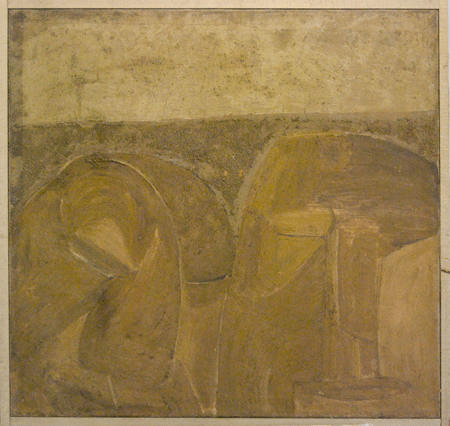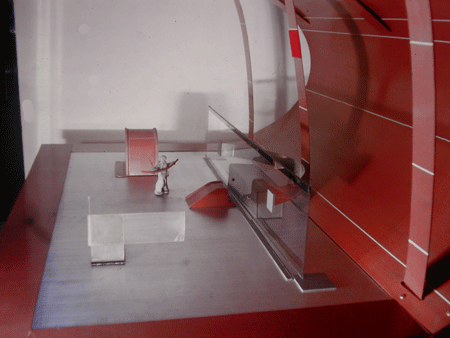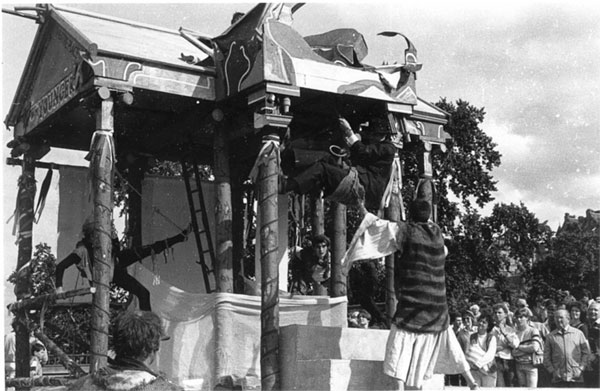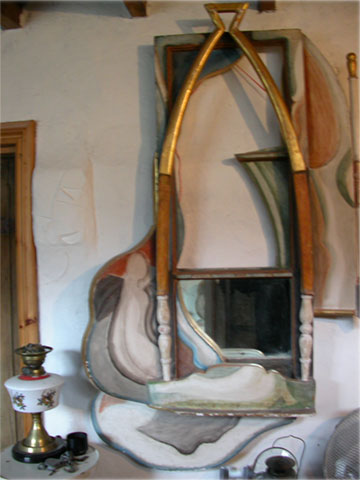|
|
| home | features | exhibitions | interviews | profiles | webprojects | gazetteer | links | archive | forum |
|
Painting as an end outside itself Ken Turner interviewed by Rupert White
Ken, you were born in Northern India, came to England just before the war and went to art school during the war. Although you're best known in Cornwall for your performance art, during the 50s and 60s you were a painter (photo below right: Heads (1960). Do want to expand on this? I think my birthplace has played a significant part in my attitude to western cultural modes of thinking. I left for England aged ten. For that reason, I think I have a questioning attitude to everything that Western thinking brings up, particularly against some forms of authority.
In 1952, John Berger was living in the same street as me so I knocked on his door and he arranged a show of my drawings at the Beaux Arts Gallery, I think, mistakenly, as part of the new social realist school. I set up a framing workshop linked to the Artists International Association’s (AIA) Gallery in Lisle Street, just north of Leicester Square. Later I moved to Clipstone Street north of Soho to set up my own business. Frank Auerbach and Leon Kossoff were two of my most interesting clients. I worked there with my wife Mary, brought up two children and went on painting with one person exhibitions at the ICA, the Lords Gallery, Heals Mansard Gallery, AIA shows and two paintings in the Tate (Britain) Millbank. We lived in Hampstead in a cheap rented flat with a communist landlady. So I was a full-blown painter and picture framer.
My exhibitions at this time around 1961 were showing a development from painting to environmental sculpture, and future cities in plastic models as works of art (photo left). I also began to see the environment as a place for performance, a public space for art in performance. These ‘models’ were showing the way towards this very clearly. The ICA exhibition was also important because I saw in this work a means to paint sculpture. Roland Penrose was encouraging in this respect. In the next year I showed some work at the Lords Gallery, St Johns Wood, that developed the idea of art and architecture in materials of wood, glass and plastic. The exhibition was called ‘Art as Something Public’, reviewed in the Studio International Magazine February 1966 by Edward Lucie-Smith, entitled ‘Art as Something Public’ - but sold only one to the Arts Council Collection, a three dimensional wall hung piece called ‘New Venice’.
Joan Littlewood, the instigator of avant-garde theatre production was instrumental in my setting up this organization. This pioneering growth of artists working in the community did eventually spark of the emergence of ‘community art’. Finally working from the Drill Hall 16 Chenies Street London WC1 off Tottenham Court Rd, with charity status, supported by the Arts Council and Camden Council. However, community art was not my intention because I remained throughout those years a ‘fine artist’ in environmental structures, (Gaumont British News televised me in 1970 as ‘This environmental artist’, rather sarcastically), working through to being a performance artist with painting as my reference to sensory and phenomenological experience.
There's a section on Action Space on your website with quite a lot more information (see link). Moving into the 70s and 80s, you became more and more involved with performance or live art of various kinds, is that right? Actually I returned to full-time painting in order to replenish and re-invigorate my original sources as a painter: but also developing the formal method of my performances. This was not easy after so much ‘action’ in the public arena. Yet I knew that my purpose remained the same: that is, fine art as the means to understand living as a critical human being and to achieve this through a link up of art and philosophy. The idea of the Postmodern intrigued me: Continental philosophers even more so. The idea of the Word in a curious way became the model for me to paint and draw, replacing the studio posed life figure.
However a change in personal circumstance saw me coming back to St. Ives, having remembered the impact that St. Ives had as a place for painters to be. But I was to be extremely disappointed.
This would have been 1993. What was St Ives like then? What was happening and what were the problems? It had changed a lot. The camaraderie amongst artists that had existed in the 50’s had gone. Modern Art had not moved forward at all. There was no real meeting place for artists. It was still living on its past glories: moribund in spirit. So I got on with my barn rebuilding and later contacted Rose Hilton who got me to apply successfully to the NSA. I gave my first performance called ‘Doubtless’ at Newlyn Art Gallery in 1994. Rose Hilton, Sandra Blow, and others were part of this performance, earlier performed at Dartington Hall, College Studios — it seemed successful as the first NSA performance art/painter member’s event.
I made several other performances in the Acorn Theatre, many at the Newlyn Art Gallery and the Millennium Gallery and Salthouse Gallery. The last linking St. Ives Public Library with the Tate Gallery, a performance action through the streets — from word to image. Though Bob Devereux gave me a retrospective exhibition in 1994, I was not really appreciated as a painter by the galleries. I put this down to the timid nature of dealers: difficult to sell and all that rubbish. I appreciate that they are really just shops selling art, but it is their duty to art to take risks, at least a modicum of risk. I now keep my paintings hidden from view, yet still waiting for a real appraisal from discerning agents or whatever. I occasionally show in NSA exhibitions. Badcocks Gallery did show me along with Sandra in 2003 and I was pleased with the postmodern (for want of a better word) feel of the show, even so they said I would do better to show in New York! And it didn’t sell: no surprise there.
The term 'Postmodern' has, I think, a special resonance in Cornwall... You mentioned the painter Sandra Blow, and indeed you were in a relationship for a period. As a painter what was Sandra's view about live art? Am I right that she resigned from the RA as a result of the Sensation show? My relationship with Sandra Blow began in the same year as the first performance in Newlyn, 1994. We struck up a friendship that developed into something more important. We both regretted the state of art in the now incorrectly named ‘artists colony’ and wished for better times when there might be a more forward and cutting way of making art: breaking boundaries. We found an affinity in painting that reminded me of art as it used to be in the best of the modern era.
We were struggling to keep at bay the St. Ives sickness, in its tendency for the pastiche of modernity and mannerism: we were remaining in a haven of thinking a little differently, though in the main I think this was kept hidden. Even though there was a gap between us in our thinking about art, we understood the nature of the formal construction of visual art. Also as yet, hidden, is the video I was making of her working in the studio with me as the critical observer on formal questions concerning the picture plane. I think that this video is a first rate view of Sandra’s working method, (and I am waiting for someone to commission me to edit and finish it for public showing!). It is document made by an artist on an artist, and has relevance for that reason: that is, not a formal documentary. Incidentally she did not resign from the Academy because of the Sensation Show.
You have become more and more interested in philosophy in recent years. Can you describe how, more generally, you see the relationship between art and philosophy? To read and muse reflectively on thoughts that expand the boundaries of thought is where art begins and grows. Joseph Beuys once said that ‘art begins with thought’; for me this is very true and always has been, but now is more vivid than ever. From Plato, Hegel and Kant and Wittgenstein to Husserl, Derrida, Virilio, Danto, and further; this remains in fact an endless search for a language of interpretation, almost a universal language that is expressive of the sensory intelligence, the imaginative intelligence and the poetics of revelation of what might be real. I don’t think any philosopher should be ignored in order to find a balance to thinking through into territories found in contemplation, because they invariably are playing, in the sense of real play, with speculations that should be the right of everyone to experience and/or investigate. Philosophy and aesthetics of art in tandem have, as such, always been a fertile ground explored by philosophers. Now it is the turn of artists to follow in their footsteps. Particularly as the Grand Narrative of Modern Art has come to an end!
Probably yes. Only the mannerists remain, only too clearly to keep the idea of Modernism going. But is this truly so? It remains a very serious question that can’t be ignored. Arthur C. Danto, a New York philosopher and art critic wrote that art ended in around 1968. Art after Duchamp must turn to philosophy. That is, the idea is art as philosophy, art as philosophy after art. In performance my colleagues and I are working with this question along with ideas on perception: perception as a means to thinking philosophically on the image and its relation to thought. Our recent performances in ‘eyeprojects’ of ‘Shifts in Perception’ – ‘This is Whatever’ and ‘Shooting Words’ all point to this crucial question. Central to this argument is the position one takes, in how and why one makes art today: emphasis is on how. I have racks full of paintings in the studio from 1950 to 2009, still increasing: a lot of performance pieces in mind, and in practice: and now this collaboration with the Thai boxing world champion, Julie Kitchen for the Exchange Gallery through the NSA’s Double Vision project. I have to state that though seemingly a socially oriented piece it also covers the territory I have been speaking about concerning the intellectual and cognitive approach to art, and this project relates to drawing with this particular approach particularly in mind. I think I’ll leave it there because most of the recent projects from 2000 to now are documented and described on the web site of the imaginativeeye. The most recent being: ‘Shifts in Perception” —‘This Is Whatever’ — ‘Shooting Words’. The last was at the Waterstone’s bookshop in Piccadilly.
http://www.imaginativeeye.co.uk Specifically on Action Space: http://www.imaginativeeye.co.uk:80/historical%20present.html This is an abridged version of the full interview: see http://www.imaginativeeye.co.uk/historicalpresence.html for full version.
5/10/09 |
|
|

 While in the army I was
offered a place at the Slade. I later declined the offer because of the
colour of the corridor walls (!) and went instead to the Anglo-French Art
School in St. Johns Wood on a demob grant to study painting. This school
was based on the Paris Atelier and was also the launch pad for the ICA:
with visiting people such as Colquhoun and MacBryde, David Sylvester,
Herbert Read, Victor Pasmore, Yankel Adler, and many French painters
including Fernand Léger.
While in the army I was
offered a place at the Slade. I later declined the offer because of the
colour of the corridor walls (!) and went instead to the Anglo-French Art
School in St. Johns Wood on a demob grant to study painting. This school
was based on the Paris Atelier and was also the launch pad for the ICA:
with visiting people such as Colquhoun and MacBryde, David Sylvester,
Herbert Read, Victor Pasmore, Yankel Adler, and many French painters
including Fernand Léger. While the framing
business was going well I began to teach at Barnet College and the
Central School and eventually St Martins from 1960 to 1980. This enabled
me to sell the business and concentrate on teaching and painting where I
think I found something new because I had to think about art. So I turned to philosophy to help out. Merleau
Ponty’s ‘Primacy of Perception’ was a book that I used in teaching
drawing.
While the framing
business was going well I began to teach at Barnet College and the
Central School and eventually St Martins from 1960 to 1980. This enabled
me to sell the business and concentrate on teaching and painting where I
think I found something new because I had to think about art. So I turned to philosophy to help out. Merleau
Ponty’s ‘Primacy of Perception’ was a book that I used in teaching
drawing.  In 1967 you founded
'Action Space', which existed for around 10 years. What was it exactly?
You used inflatables a lot (see photo right)...
In 1967 you founded
'Action Space', which existed for around 10 years. What was it exactly?
You used inflatables a lot (see photo right)... I had moved to Yorkshire
from London in 1980, and lived there for two years, but before that I
had made many performances in London at the Drill Hall, Battersea Art
Centre, The ICA, and further afield at York Minster, Yorkshire sculpture
Park, the Edinburgh Festival (picture right), and the Zap Club, Brighton, also an
exhibition of Architectural Mirrors at the Moira Kelly Gallery
Islington (picture below).
I had moved to Yorkshire
from London in 1980, and lived there for two years, but before that I
had made many performances in London at the Drill Hall, Battersea Art
Centre, The ICA, and further afield at York Minster, Yorkshire sculpture
Park, the Edinburgh Festival (picture right), and the Zap Club, Brighton, also an
exhibition of Architectural Mirrors at the Moira Kelly Gallery
Islington (picture below).  The
piece was grappling with the text of Derrida and deconstruction, taking
in Nietzsche, Heidegger and other philosophers. Apart from Rose and
Sandra, Rory McDermott, Alaric Sumner also took part and others. I found
however, that there was as yet no audience for performance art, and I
don’t think this has changed much.
The
piece was grappling with the text of Derrida and deconstruction, taking
in Nietzsche, Heidegger and other philosophers. Apart from Rose and
Sandra, Rory McDermott, Alaric Sumner also took part and others. I found
however, that there was as yet no audience for performance art, and I
don’t think this has changed much. Sandra
appreciated and liked my performances and painting. We talked a lot on
concepts found in philosophy and its relation to painting and
performance. She was interested in continental philosophy but also had a
liking for Marcus Aurelius, the Roman Emperor Philosopher. I will always
remember how rich our relationship was and beneficial to us both.
Sandra
appreciated and liked my performances and painting. We talked a lot on
concepts found in philosophy and its relation to painting and
performance. She was interested in continental philosophy but also had a
liking for Marcus Aurelius, the Roman Emperor Philosopher. I will always
remember how rich our relationship was and beneficial to us both.